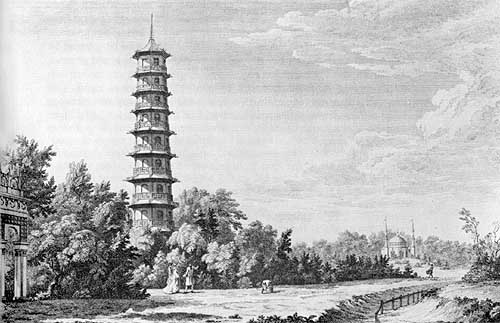|
William Chambers |
William Chambers (1723-1796)
A Dissertation on Oriental Gardening,1772 (excerpt)
Though the Chinese artists have nature for their general model, yet are they not so attached to her as to exclude all appearance of art; on the contrary, they think it, on many occasions, necessary to make an ostentatious shew of their labour. Nature, say they, affords us but few materials to work with. Plants, ground and water, are her only productions: and though both the forms and arrangements of these may be varied to an incredible degree, yet have they but few striking varieties, the rest being of the nature of changes rung upon bells, which, though in reality different, still produce the same uniform kind of jingling; the variation being too minute to be easily perceived.
Art must therefore supply the scantiness of nature; and not only be employed to produce variety, but also novelty and effect: for the simple arrangements of nature are met with in every common field, to a certain degree of perfection; and are therefore too familiar to excite any strong sensations in the mind of the beholder, or to produce any uncommon degree of pleasure.
It is indeed true that novelty and variety may both be attained by transplanting the peculiarities of one country to another; by introducing rocks, cataracts, impending woods, and other parts of romantic situations, in flat places; by employing much water where it is rare; and cultivated plains, amidst the rude irregularities of mountains: but even this resource is easily exhausted, and can seldom be put in practice, without a very great expence.
The Chinese are therefore no enemies to strait lines; because they are, generally speaking, productive of grandeur, which often cannot be attained without them: nor have they any aversion to regular geometrical figures, which they say are beautiful in themselves, and well suited to small compositions, where the luxuriant irregularities of nature would fill up and embarrass the parts they should adorn. They likewise think them properest for flower gardens, and all other compositions, where much art is apparent in the culture; and where it should therefore not be omitted in the form.
Their regular buildings they generally surround with artificial terrasses, slopes, and many flights of steps; the angles of which are adorned with groupes of sculpture and vases, intermixed with all sorts of artificial waterworks, which, connecting with the architecture, serve to give it consequence, and add to the gaiety, splendor, and bustle of the scenery.
Round the main habitation, and near all their decorated structures, the grounds are laid out with great regularity, and kept with great care: no plants are admitted that intercept the view of the buildings; nor no lines but such as accompany the architecture properly, and contribute to the general good effect of the whole composition: for they hold it absurd to surround an elegant fabric with disorderly rude vegetation; saying, that it looks like a diamond set in lead; and always conveys the idea of an unfinished work. When the buildings are rustic, the scenery which surrounds them is wild; when they are grand, it is gloomy; when gay, it is luxuriant: in short, the Chinese are scrupulously nice in preserving the same character through every part of the composition; which is one great cause of that surprizing variety with which their works abound.
They are fond of introducing statues, busts, bas-reliefs, and every production of the chisel, as well in other parts of their Gardens, as round their buildings; observing, that they are not only ornamental, but that by commemorating past events, and celebrated personages, they awaken the mind to pleasing contemplation, hurrying our reflections up into the remotest ages of antiquity: and they never fail to scatter antient inscriptions, verses, and moral sentences, about their grounds; which are placed on large ruinated stones, and columns of marble, or engraved on trees and rocks; such situations being always chosen for them, as correspond with the sense of the inscriptions; which thereby acquire additional force in themselves, and likewise give a stronger expression to the scene . . .
Such is the common scenery of the Chinese Gardens, where the ground has no striking tendency to any particular character. But where it is more strongly marked, their artists never fail to improve upon its singularities; their aim is to excite a great variety of passions in the mind of the spectator; and the fertility of their imaginations, always upon the stretch in search of novelty, furnishes them with a thousand artifices to accomplish that aim.
The scenes which I have hitherto described, are chiefly of the pleasing kind: but the Chinese Gardeners have many sorts, which they employ as circumstances vary; all which they range in three separate classes; and distinguish them by the appellations of the pleasing, the terrible, and the surprizing.
The first of these are composed of the gayest and most perfect productions of the vegetable world; intermixed with rivers, lakes, cascades, fountains, and water-works of all sorts: being combined and disposed in all the picturesque forms that art or nature can suggest. Buildings, sculptures, and paintings are added, to give splendor and variety to these compositions; and the rarest productions of the animal creation are collected; to enliven them: nothing is forgot that can either exhilerate the mind, gratify the senses, or give a spur to the imagination.
Their scenes of terror are composed of gloomy woods, deep vallies inaccessible to the sun, impending barren rocks, dark caverns, and impetuous cataracts rushing down the mountains from all parts. The trees are ill formed, forced out of their natural directions, and seemingly torn to pieces by the violence of tempests: some are thrown down, and intercept the course of the torrents; others look as if blasted and shattered by the power of lightening: the buildings are in ruins; or half consumed by fire, or swept away by the fury of the waters: nothing remaining entire but a few miserable huts dispersed in the mountains, which serve at once to indicate the existence and wretchedness of the inhabitants. Bats, owls, vultures, and every bird of prey flutter in the groves; wolves, tigers and jackalls howl in the forests; halffamished animals wander upon the plains; gibbets, crosses, wheels, and the whole apparatus of torture, are seen from the roads; and in the most dismal recesses of the woods, where the ways are rugged and overgrown with weeds, and where every object bears the marks of depopulation, are temples dedicated to the king of vengeance, deep caverns in the rocks, and descents to subterraneous habitations, overgrown with brushwood and brambles; near which are placed pillars of stone, with pathetic descriptions of tragical events, and many horrid acts of cruelty, perpetrated there by outlaws and rcbbers of former times: and to add both to the horror and sublimity of these scenes, they sometimes conceal in cavities, on the summits of the highest mountains, founderies, lime-kilns, and glass-works; which send forth large volumes of flame, and continued columns of thick smoke, that give to these mountains the appearance of volcanoes.
Their surprizing, or supernatural scenes, are of the romantic kind, and abound in the marvellous; being calculated to excite in the minds of the spectators, quick successions of opposite and violent sensations. Sometimes the passenger is hurried by steep descending paths to subterraneous vaults, divided into apartments, where lamps, which yield a faint glimmering light, discover the pale images of antient kings and heroes, reclining on beds of state; their heads are crowned with garlands of stars, and in their hands are tablets of moral sentences: flutes, and soft harmonious organs, impelled by subterraneous waters, interrupt, at stated intervals, the silence of the place, and fill the air with solemn melody.
Sometimes the traveller, after having wandered in the dusk of the forest, finds himself on the edge of precipices, in the glare of day-light, with cataracts falling from the mountains around, and torrents raging in the depths beneath him; or at the foot of impending rocks, in gloomy vallies, overhung with woods, on the, banks of dull moving rivers, whose shores are covered with sepulchral monuments, under the shade of willows, laurels, and other plants, sacred to Manchew, the genius of sorrow.
His way now lies through dark passages cut in the rocks, on the side of which are recesses, filled with colossal figures of dragons, infernal fiends, and other horrid forms, which hold in their monstrous talons, mysterious, cabalistical sentences, inscribed on tables of brass; with preparations that yield a constant flame; serving at once to guide and to astonish the passenger: from time to time he is surprized with repeated shocks of electrical impulse, with showers of artificial rain, or sudden violent gusts of wind, and instantaneous explosions of fire; the earth trembles under him, by the power of confined air; and his ears are successively struck with many different sounds, produced by the same means; some resembling the cries of men in torment; others the roaring of bulls, and howl of ferocious animals, with the yell of hounds, and the voices of hunters; others are like the mixed croaking of ravenous birds; and others imitate thunder, the raging of the sea, the explosion of cannon, the sound of trumpets, and all the noise of war.
His road then lies through lofty woods, where serpents and lizards of many beautiful sorts crawl upon the ground, and where innumerable monkies, cats and parrots, clamber upon the trees, and intimidate him as he passes; or through flowery thickets, where he is delighted with the singing of birds, the harmony of flutes, and all kinds of soft instrumental music: sometimes, in this romantic excursion, the passenger finds himself in extensive recesses, surrounded with arbors of jessamine, vine and roses, where beauteous Tartarean damsels, in loose transparent robes, that flutter in the air, present him with rich wines, mangostans, ananas, and fruits of Quangsi; crown him with garlands of flowers, and invite him to taste the sweets of retirement, on Persian carpets, and beds of camusath skin down . . .
European artists must not hope to rival Oriental splendor; yet let them look up to the sun, and copy as much of its lustre as they can, circumstances will frequently obstruct them in their course, and they may often be prevented from soaring high: but their attention should constantly be fixed on great objects; and their productions always demonstrate, that they knew the road to perfection, had they been enabled to proceed on the journey.
Where twining serpentine walks, scattering shrubs, digging holes to raise mole-hills, and ringing never-ceasing changes on lawns, groves and thickets, is called Gardening, it matters little who are the Gardeners; whether a peasant or a Poussin; whether a child in sport, or a man for hire: the meanest may do the little there is to be done, and the best could reach no farther. But wherever a better style is adopted, and Gardens are to be natural, without resemblance to vulgar Nature; new without affectation, and extraordinary without extravagance; where the spectator is to be amused, where his attention is constantly to be kept up, his curiosity excited, and his mind agitated by a great variety of opposite passions; there Gardeners must be men of genius, experience and judgement; quick in perception, rich in expedients, fertile in imagination, and thoroughly versed in all the affections of the human mind.
|
Plate from William Chambers, Plans, Elevations, Sections, and Perspective Views of the Gardens and Buildings at Kew in Surry, 1763
|
William Chambers
(1723-1796)
A Dissertation on
Oriental Gardening,1772
(excerpt)
Source:
John Dixon Hunt & Peter
Willis (eds.).
The Genius of the Place:
The English Landscape Garden 1620-1820.
London: Paul Elek Ltd, (1975)
1979; pp.318-22, ill. p.287

